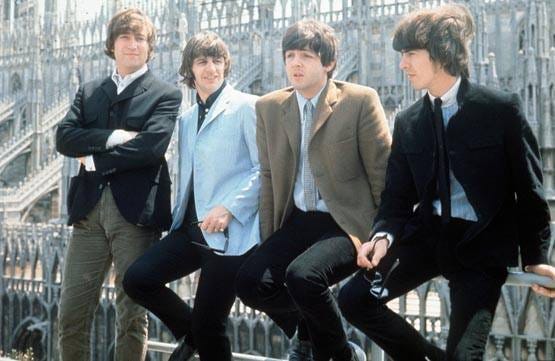The Beatles, Dylan and Rubber Soul

New York, 1964 at the Delmonico Hotel, the Beatles were taking a breather from the first of two shows at the Forest Hills Stadium. A mutual friend, Al Aronowitz, brokered a meeting of minds and out walked the raspy-voiced folk icon, Bob Dylan with enough joints to go around and back again. The meat of the matter: Dylan showed the Beatles marijuana, which ended the child-like innocence of the Beatles that even grandma and granddad could get behind. From the red-eyed depths, out came a new, unrecognisable, post-mindblown, Beatles, and the mop-topped, suited and booted, foursome were no more.
With a simple twist of fate, the Beatles’ previously pristinely cut caricature of the good boys was no more after 1964 — Dylan was Michelangelo’s God reaching to Adam as he passed the Beatles a joint or two.
As reductionist rock ’n’ roll yarns go, this one is a favourite of midnight bar conversation. Dylan was a major influence on the Beatles, but not solely from his dealer’s number and that night at the Delmonico Hotel.
By 1964 John Lennon’s creative process was shifting. Beatles for Sale was released in the same year proving to be a pop leviathan in the UK. One year later, and the Beatles scored another hit with Help! With Dylan at the forefront, the folk scene was booming across the 1960s, and the Beatles were beginning to flirt with it.
“You’ve Got To Hide Your Love Away is my Dylan period. It’s one of those that you sing a bit sadly to yourself, ‘Here I stand, head in hand…’ I’d started thinking about my own emotions. I don’t know when exactly it started, like I’m A Loser or Hide Your Love Away, those kind of things. Instead of projecting myself into a situation, I would try to express what I felt about myself, which I’d done in my books. I think it was Dylan who helped me realise that — not by any discussion or anything, but by hearing his work.”
https://www.beatlesbible.com/songs/youve-got-to-hide-your-love-away/
The Beatles were slowly turning their backs on adolescent screams, but the lingering shape of the sharply-dressed foursome was still present. Beatles for Sale and Help! were a little more mature and introspective from previous albums, but the widely regarded turning-point, if you like, is only really seen and heard by Rubber Soul released in 1965.
Before that though, Dylan was having a turning-point of his own…

Dylan’s Bringing It All Back Home and Highway 61 Revisited had been released a few months prior to Rubber Soul marking a critical juncture in Dylan’s career. Like the Beatles, Dylan was starting to reinvent himself. Much to the chagrin of his turtle-necked audience, Dylan put his acoustic away for an electric and began to manoeuvre further and further away from protest songs.
The infamous concert at Newport festival surmised Dylan’s turning-point of plugging-in and being booed offstage, but the changing form of Dylan didn’t happen overnight. Another Side of Bob Dylan released in 1964 was too met with criticism from some of his more militant folk fans through its lack of protest songs. Dylan was regarded as something of a folk prophet in the tumultuous times of the ’60s, but its personal themes were perceived as a betrayal to their construct. By the time Dylan went completely electric his disciples had packed their bags.
Not one to relish in the figment of being a kind of curly-haired Christ-like figure Dylan, in response to feeling owned by his audiences, said,
“As far as I knew, I didn’t belong to anyone then or now… the big bugs in the press kept promoting me as the mouthpiece, spokesman, or even conscience of a generation. That was funny. All I’d ever done was sing songs that were dead straight and expressed powerful new realities. I had very little in common with and knew even less about a generation that I was supposed to be the voice of.”
And In defence of going electric Dylan reflected,
“I thought I’d get more power with a small group backing me. It was electric but that doesn’t necessarily mean it’s modernised just because it’s electric.”
Just as every musician who is worth their salt does, Dylan was evolving. His voyage into performing and recording with an electric band, and his new lyrical themes were a symptom of that evolution just as the Beatles were evolving alongside him into psychedelic long-hairs.
Ever influenced by the works of Dylan, it seemed the Beatles were too sharing in Dylan’s desire to truly shed their former skin with the release of Rubber Soul. Rubber Soul was the progression of Help! just as Bringing It All Back Home was the progression of Another Side Of Bob Dylan. The Beatles’ teenage screams and Dylan’s wistful beatniks were leaving, and a new era was being ignited. Dylan went electric and the Beatles dropped Rubber Soul!
Ranked at number five in the Rolling Stone’s greatest albums of all time, Rubber Soul showed the music world that the Beatles were legitimate artists. In place of “I Want to Hold Your Hand” and “Twist and Shout” there was “Norwegian Wood” and “Nowhere Man.” Mellow and self-reflective, the up-beat teenage boy meets teenage girl dynamic had shifted into themes of self-exploration and of social awareness. That’s not to say that the idea of boy meets girl is altogether lost on Rubber Soul, but its treatment was a little less pedestrian.
The masterfully gloomy “Girl,” provided a more unique and disillusioned take on the intricacies of the heart. It’s melancholic though not because of the typical theme of love lost, rather, it presents a theme of almost parasitical love.
When I think of all the times I’ve tried so hard to leave her
She will turn to me and start to cry
And she promises the Earth to me and I believe her
After all this time I don’t know why
Lennon explores his co-dependency to the woman in question, yet he is later disenfranchised by the one-way relationship.
Was she told when she was young that pain would lead to pleasure?
Did she understand it when they said
That a man must break his back to earn his day of leisure?
Will she still believe it when he’s dead?
The song shows love in a truer, complex form. It’s a sophistication, and a line in the sand from the past lyrics of two lovers as entirely simpatico. John reflects more on his role within that relationship and externalises the unspoken internal. His insecurities as a lover are put on display making for a beautiful and yet tragic song of self-examination.
Developing on Dylan’s lyrical influence, self-examination and curiosity were strong themes of Rubber Soul. Dylan even responded to “Norwegian Wood” with a song of his own, “4th Time Around” as a tongue-in-cheek homage to their thoroughly Dylan-esque album. The strong themes of self-examination and curiosity were perhaps also a corollary of all the weed the Beatles were smoking at the time…
Despite popular belief, Dylan wasn’t the Beatles’ first stingy-eyed shaman; that came years earlier, though the event had not made any significant impact on the four. Dylan had assumed that the Beatles were fellow partakers of his funny-smelling cigarettes after mistakenly hearing the lyrics to “I Want to Hold Your Hand” as “I get high” rather than “I can’t hide”. Not that it mattered. Despite Dylan’s lyrical faux pas, after that night, and by the time of Rubber Soul, weed had become something of a recreational past-time for the Beatles. John Lennon stated that after that night,
“The Beatles had gone beyond comprehension. We were smoking marijuana for breakfast. We were well into marijuana and nobody could communicate with us, we were just glazed eyes, giggling all the time.”
Here were the polar opposites of the ragtag Rolling Stones falling from heaven and getting in on the fun, so to speak, that had swept the 1960s. This was in no small part thanks to Dylan playing the serpent at the Delmonico Hotel, but the thin man’s music was an equally intoxicating influence.
The music of Rubber Soul followed in the same explorative footsteps of its lyrical themes. Taking influences from Dylan and the Byrds, the Beatles were born again in the guise of electric-folk and a faint ghost of psychedelia.
For the aforementioned “Norwegian Wood,” George donned the sitar, which was previously unheard of within the realms of pop music. As with Dylan at the time, it conveyed the four digging for something new and fresh. “Norwegian Wood” was something of a misnomer in comparison to anything the Beatles had recorded earlier. By his use of the sitar, George, in-part, unwittingly created a newfound sub-genre, raga rock. Later into the 1960s, the use of the sitar became something of a staple for psychedelia and psychedelic pop. A new era had been struck, and the Beatles were at the helm.
Proving that Harrison could be a key player within the Beatles as a songwriter, “Think for Yourself” was George pushing through the ironclad songwriting dominion of Lennon and McCartney. Although it wasn’t his first song to feature on a Beatles album, it was a more accomplished stepping stone of Harrison’s songwriting capabilities. A celebration of the necessity of autonomous thought, it’s rather poignant considering George had always been regarded as the quiet one somewhat overshadowed by Lennon and McCartney.
Just as the sitar became a go-to for ’60s psychedelia, McCartney’s fuzzy bass tone on “Think for Yourself” too showed Rubber Soul’s musical prescience. It is widely contested as to whether Paul was in fact, the first to use fuzz on his bass because Marty Robbins often gets the credit. Regardless, the tone hadn’t yet become as iconic as it later did, McCartney was at least one of its early pioneers.
From mop-top to munchies, Rubber Soul was the Beatles truly beginning to innovate. They had cast off the shackles of their former suited selves and the rest, as they, was history.
Revolver followed on from Rubber Soul and Sgt. Pepper’s Lonely Hearts Club Band followed that. With a little help from Dylan, the Beatles were on their way to truly becoming the Beatles.
Sources
https://www.wideopencountry.com/how-marty-robbins-accidentally-pioneered-guitar-fuzz-effects/
https://guitar.com/features/interviews/paul-mccartney-beatles-wings/
https://pitchfork.com/reviews/albums/13433-rubber-soul/
https://www.beatlesbible.com/songs/norwegian-wood-this-bird-has-flown/
https://www.aaronkrerowicz.com/beatles-blog/bob-dylans-influence-on-the-beatles
https://ultimateclassicrock.com/bob-dylan-introduces-beatles-to-marijuana/
https://www.beatlesbible.com/songs/think-for-yourself/
https://liveforlivemusic.com/features/bob-dylan-beatles-marijuana-1964/
https://www.beatlesbible.com/songs/youve-got-to-hide-your-love-away/
https://www.nme.com/news/music/bob-dylan-238-1354198
